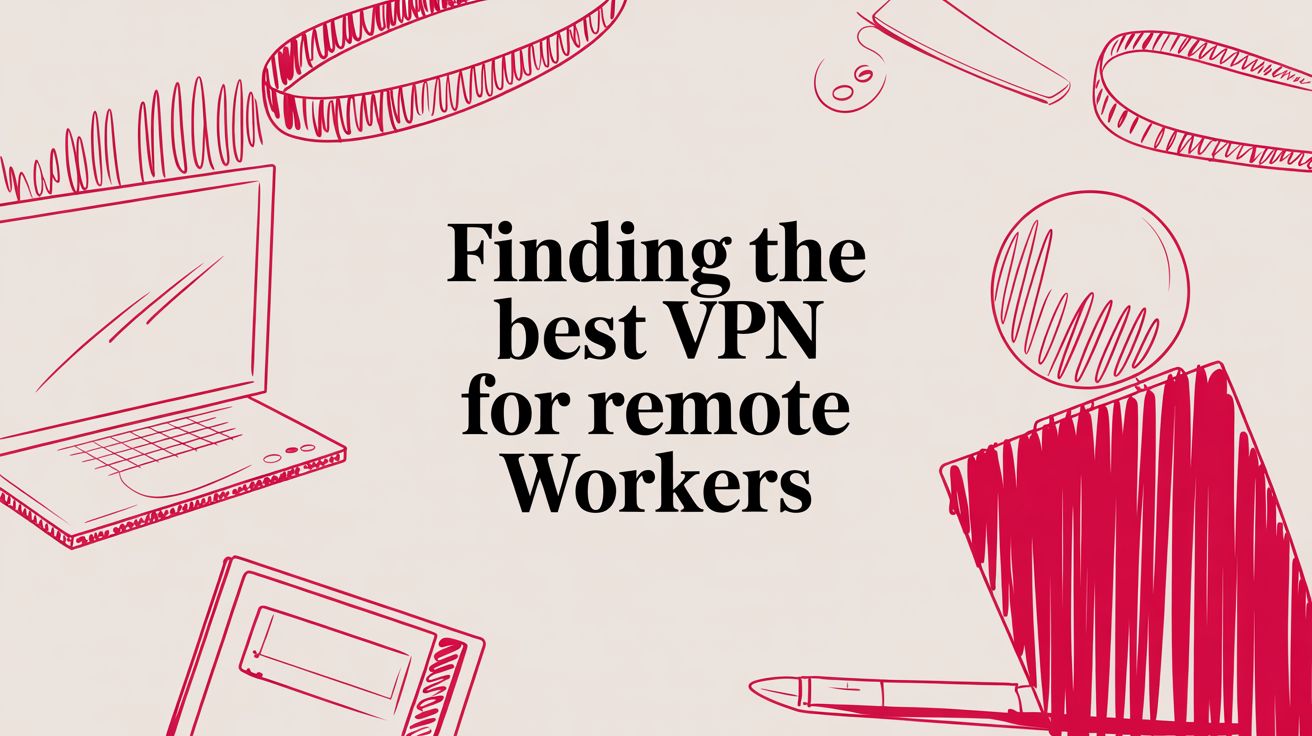Remote Workforce Management: From Chaos to Clarity
Max
Building Your Remote Foundation (Without the Headaches)

This infographic highlights some interesting stats about remote work. Notice how companies are generally supportive and seeing productivity gains, but communication still poses a challenge. That tells us something important: simply allowing remote work isn’t enough. We need to actively build a communication framework to really make it work. A solid onboarding process is essential here, and this resource on Remote Employee Onboarding can really help.
Essential Infrastructure for Remote Workforce Management
Think of setting up a remote workforce like building a house. You can’t just start decorating – you need a solid foundation first. That means the right tech, of course, but also things like clear policies and workflows.
Reliable Communication Tools: You’ll need tools for both real-time and asynchronous communication. Think video conferencing with Zoom, instant messaging with Slack, and a project management platform like Asana. I learned the hard way that keeping project updates separate from casual chatter makes a huge difference in clarity.
Crystal-Clear Remote Work Policy: This is your remote “constitution.” Document everything: working hours, communication expectations, equipment, security protocols – the whole nine yards. It prevents so many headaches down the road.
Streamlined Workflows: Map out how things get done, from project approvals to expense reports. Think about how to optimize these for a remote setup. For example, switching to digital approvals completely eliminates the need for chasing down physical signatures.
Navigating the Hybrid Landscape
Hybrid work throws a unique wrench into the mix. We’ve seen a real surge in remote work recently, especially in bigger markets. By Q1 2025, about 40% of jobs offered some kind of remote option, though this varied a lot based on location and the type of work. Places with large metro areas like Massachusetts, Minnesota, New York, Oregon, and Colorado tended to favor hybrid setups over fully remote, with Massachusetts leading the charge at 31%. It’s interesting to see that preference for hybrid in urban centers – a kind of balance between flexibility and in-person interaction. Overall, remote work has become much more common. Over 15% of U.S. job opportunities are now remote, way up from about 4% before the pandemic. You can dig into more of those stats here. Managing a mix of in-office and remote folks requires a little extra finesse. Here’s what I’ve found helpful:
Designated “Office Days”: Setting aside specific days for in-office collaboration can really boost team bonding and make those important face-to-face discussions happen.
Hybrid Meeting Etiquette: Think about how to make sure remote participants feel included in hybrid meetings. Using high-quality video conferencing is a must, and maybe even designate someone to specifically “voice” questions from those dialing in.
Flexible Scheduling Tools: Using software to manage hybrid schedules, book desks, and coordinate with colleagues makes everyone’s lives so much easier.
Before we go further, let’s take a look at the different remote work models available:
To help you navigate this landscape, I’ve put together a comparison table outlining the key differences between various remote work models. This will help you choose the best fit for your organization’s needs.
| Work Model | Structure | Best For | Key Benefits | Common Challenges |
|---|---|---|---|---|
| Fully Remote | Entirely work-from-home; no office required | Companies with globally distributed teams, digital-first businesses | Maximum flexibility, reduced overhead costs, access to wider talent pool | Difficulty fostering team cohesion, potential communication issues, reliance on technology |
| Hybrid | Employees split time between the office and remote work | Companies transitioning to remote work, teams requiring in-person collaboration | Balance of flexibility and in-person interaction, fosters team connection | Requires careful planning and coordination, potential for inequality between remote and in-office employees |
| Flexible | Employees choose where and when they work within certain parameters | Companies focused on employee autonomy and work-life balance | Increased employee satisfaction and productivity, adaptable to individual needs | Requires clear communication and trust, may be challenging to manage |
As you can see, each model has its own unique advantages and disadvantages. Carefully consider your company culture, business needs, and employee preferences when making your decision.
Building a solid remote foundation takes time, but it’s worth it. You’ll see the payoff in productivity, happier employees, and a more successful business overall. Prioritizing clear communication, efficient workflows, and a supportive remote policy is key. That’s how you build a thriving remote team ready to tackle anything.
Communication That Actually Enhances Productivity

This screenshot shows how Slack channels help organize conversations by topic or project. For remote teams, this kind of structured communication is a real game changer.
Let’s be honest, constant notifications and back-to-back meetings can absolutely kill productivity. Managing a remote workforce effectively means creating a smarter communication strategy. It’s about knowing when a conversation needs to happen live and when it can happen later. Asynchronous communication is all about respecting people’s time and focus.
It lets folks respond when they’re ready, minimizing interruptions and maximizing deep work time.
Mastering Asynchronous Communication
Embracing asynchronous communication was a huge shift in my own remote work experience. For example, instead of scheduling a meeting for project updates, I started using project management tools with built-in comment features. It allows for targeted feedback without derailing everyone’s flow.
And for quick questions? Instant messaging is a lifesaver. Setting up clear communication channels is fundamental to a good remote setup. You might want to check out some helpful resources like this article on remote team communication strategies. But knowing when to use which channel is where the magic happens.
Respecting Global Time Zones
With a globally distributed team, time zones are a big deal. I’ve found that rotating meeting times helps make sure everyone gets a chance to participate in key discussions at a reasonable hour. But even then, relying too much on meetings can still be a problem.
Solid documentation is essential for making asynchronous communication truly effective. A well-maintained knowledge base can answer frequently asked questions, freeing everyone up for more strategic work.
Building Psychological Safety
Creating a sense of psychological safety in a digital environment is key to open communication. It means building a culture where people feel comfortable sharing ideas, asking questions, and even admitting mistakes without worrying about judgment.
Informal communication channels, like a dedicated “water cooler” chat, can help build rapport and a more relaxed vibe. For more tips on staying motivated and connected while working remotely, check out our guide on staying motivated while working from home.
Remember, effective remote communication is about more than just tools. It’s about a culture of respect, trust, and flexibility. It’s about setting everyone up to do their best work.
Performance Management Without the Micromanaging

I know a lot of managers get nervous about remote work because they feel like they’re losing control. That “out of sight, out of mind” thing can really kick in. This often leads to micromanaging, which never works well, but it’s especially damaging with remote teams. It’s ironic, but trying to control everything often means you end up controlling nothing. Instead of worrying about how people work, concentrate on what they produce.
Shifting to Outcome-Based Performance
This means ditching the surveillance and building an outcome-based system. Figure out what you want to achieve and set clear, measurable objectives. Then, give your team the freedom to get it done. For example, instead of dictating specific work hours, focus on project deadlines and what needs to be delivered. This empowers your team and builds trust. Plus, regular check-ins become a conversation about progress, roadblocks, and offering support, not tracking every minute of their day. A good resource for managing remote teams is this guide on managing distributed teams. I’ve found it helpful myself.
Setting Clear Expectations (For All Personality Types)
Remember, everyone works differently. Some people love a structured routine, others need more flexibility. When you’re setting expectations, consider different working styles and personalities. This might mean flexible deadlines or letting team members choose their own working hours (within reason, of course). The important thing is finding a balance that lets individuals have autonomy while still meeting the overall team goals. A solid communication plan is also key to remote team productivity. I’ve found this Internal Communications Plan Template to be a real lifesaver.
Accountability and Data-Driven Support
Accountability isn’t about spying. It’s about setting up systems to help everyone stay on track and spot potential problems early. Project management tools like Asana or Trello can help track progress, visualize deadlines, and make communication easy. The data from these tools can then be used to support your team, not to police them. For example, if someone consistently misses deadlines, the data can help you figure out why and offer real, targeted support. Maybe they need more training, a lighter workload, or a mentor. This whole shift to remote work has massively impacted employee engagement and productivity. Studies actually show a 13% performance increase and a 50% drop in quit rates for remote workers, resulting in higher profit per employee. If you’re interested in diving into these trends, you can learn more about remote work statistics here. By focusing on outcomes and empowering your team, you can build a performance management system that actually works for a remote setting.
To help visualize this, check out this table I put together:
Remote Performance Metrics Dashboard: Key performance indicators and metrics for effectively measuring remote workforce productivity and engagement
| Metric Category | Specific Measures | Tracking Frequency | Success Indicators | Red Flags |
|---|---|---|---|---|
| Output | Projects completed, tasks finished, deadlines met | Weekly | Consistent completion of tasks and projects, meeting or exceeding targets | Missed deadlines, declining output, incomplete projects |
| Quality of Work | Client feedback, error rates, peer reviews | Project-based, quarterly | Positive client feedback, low error rates, positive peer reviews | Negative feedback, increasing error rates, inconsistent quality |
| Communication | Responsiveness to emails/messages, participation in team meetings | Daily/Weekly | Timely responses, active engagement in meetings, clear and concise communication | Delayed responses, lack of participation, communication breakdowns |
| Engagement | Participation in team activities, feedback in surveys, initiative on projects | Monthly/Quarterly | Active involvement in team events, positive feedback, proactive approach to work | Withdrawal from team activities, negative feedback, lack of initiative |
| Time Management | Time spent on tasks, adherence to schedules | Weekly | Efficient use of time, consistent adherence to schedule, timely completion of tasks | Overspending time on tasks, frequent deviations from schedule, inability to meet deadlines |
This table summarizes some of the key areas to monitor when managing a remote team. Remember, it’s about supporting your team, not micromanaging. Using these metrics can help you identify areas where individuals might need help, leading to a more productive and engaged remote workforce.
Building Culture When You Can’t Share Coffee

Company culture isn’t about beanbag chairs or catered lunches. It’s the heartbeat of your organization – the shared values, connections, and sense of belonging that keeps everyone moving in the same direction. Building that when everyone’s scattered across different zip codes (or time zones!) requires a whole different approach. Forget the awkward virtual happy hours and forced “fun.” Thriving remote cultures are built on genuine connection and meaningful interactions.
Onboarding Beyond the Basics
Onboarding is like a first impression – it sets the stage for the entire employee experience. And for remote teams, it’s even more critical. Think about it: new hires miss out on those casual office interactions where they absorb company norms and build relationships organically. A robust remote onboarding program needs to go way beyond paperwork and system logins.
- Introductions to key team members (not just their boss!)
- Virtual coffee chats with colleagues in different departments
- A buddy system for the first few weeks to help navigate the ropes
These small touches can make a huge difference in how quickly new hires feel welcomed and integrated into the team.
Celebrating Wins, Big and Small
Celebrating successes, no matter how small, is rocket fuel for a positive remote culture. Acknowledging accomplishments reinforces your company values and strengthens the bonds between team members. It doesn’t have to be complicated.
- Virtual awards ceremonies can be surprisingly fun
- Personalized e-cards show you care
- A dedicated Slack channel for shout-outs creates a constant stream of positivity
One company I know sends small gift cards to team members for hitting milestones. It’s a small gesture, but it goes a long way.
Mentorship Across the Miles
Mentorship programs can actually thrive in a remote setting. Pairing experienced team members with newer hires offers valuable guidance and support, bridging the gap created by physical distance.
- Regular virtual meetings provide structured learning opportunities
- Shared projects foster collaboration and skill development
- Even casual check-ins build rapport and create a sense of connection
This is especially valuable for remote employees who might feel isolated or miss out on informal mentorship opportunities that naturally occur in an office setting. For more thoughts on this, check out this article on remote work culture.
Navigating Challenging Times Together
When challenges pop up (and they will!), remote teams need a support system. A strong culture provides that safety net during tough times. Open communication is absolutely key. Encourage team members to share their struggles and be proactive in offering resources for mental health and well-being. One company I worked with implemented weekly “pulse checks” to gauge employee morale and offer targeted support. It made a world of difference. With an estimated 75% of employed adults potentially working from home at least part-time by 2025, and a whopping 98% of remote workers wanting to continue and recommend it, the future of work is remote. For a deeper dive into these trends and the emerging discussion about remote work as a legal right, you can discover more statistics here. Ultimately, building a strong remote culture takes intention and a bit of creativity. But trust me, it’s an investment that pays off big time in higher engagement, improved performance, and a more resilient team.
Scaling Remote Operations (Before They Break)
I’ve seen amazing remote teams flourish, and I’ve also seen them, well, not. What works for a small, tight-knit group can completely unravel as you scale. It’s like a recipe – perfect for four servings, but when you try to make it for forty, it’s a whole different story. One startup I worked with went from 10 to 50 remote employees in a year. Initially, their remote culture was fantastic, but that rapid growth brought communication breakdowns, silos, and decision-making gridlock. They just hadn’t planned for the need for more structure and dedicated roles as they grew.
Evolving Your Communication and Collaboration
When your team is small, keeping everyone in the loop is easy. A quick message here, a casual chat there, and everyone’s on the same page. But as you grow, informal communication just won’t cut it. You need systems. Think of it like upgrading from a small town’s single traffic light to a big city’s complex network. You need a strategy for each department that keeps information flowing freely and encourages collaboration.
Here are a few things that have worked well for me and the teams I’ve supported:
- A robust knowledge base: Think of this as your team’s central brain. Having key information readily available reduces the constant barrage of messages and keeps everyone informed.
- Dedicated communication channels: Instead of one giant, chaotic chat room, create separate channels for each department. This keeps project updates and team-specific discussions organized and easy to follow.
- Regular cross-functional meetings: These are crucial for connecting the dots between different teams. A short, weekly meeting can keep everyone aligned on company goals and prevent silos from forming.
Adapting Your Management Structure
Often, growing pains come from a management structure that hasn’t adapted to the team’s size. As your team expands and layers of management emerge, maintaining quick decision-making can be a challenge. It’s easy for decisions to get stuck at the top, slowing everything down.
The key here is empowerment. Trust your middle managers to make decisions within their areas of expertise. This not only speeds things up but also develops your leadership team and fosters a sense of ownership. For more on this, check out our guide on remote work best practices. It covers a lot of helpful ground.
Investing in Remote Operations Roles
As your remote team expands, think about bringing in dedicated remote operations professionals. Someone with the title of Head of Remote or Remote Operations Manager can be a game-changer. Their focus is solely on making the remote experience the best it can be, ensuring your systems and policies can handle the growth.
Their expertise can be invaluable for things like:
- Crafting and implementing remote-specific policies.
- Managing the technology and infrastructure that supports remote work.
- Boosting communication and collaboration across different teams.
- Tackling those unique challenges that come with having a distributed workforce.
Scaling remote operations isn’t a set-it-and-forget-it task. It requires proactive planning and the ability to adapt as you go. By focusing on communication, management structure, and specialized roles, you can keep the advantages of remote work while avoiding the common pitfalls of growing quickly. Ultimately, it’s about building a scalable remote workforce management system that’s ready for anything and supports your team’s ongoing success.
Solving the Problems Nobody Talks About
Remote work isn’t always sunshine and rainbows. Even when you think you’ve got it all figured out, tricky human issues can pop up and throw a wrench in the works. These aren’t problems you can fix with a quick checklist or a company-wide email. They need a more personal touch.
The Underperformer in the Digital Shadows
Dealing with an underperforming team member is never easy, but it’s even tougher when you’re not in the same room. One mistake I see a lot is managers relying on emails or instant messages for these conversations. These just aren’t the right tools for sensitive discussions. They lack the nuance of a real conversation and can easily lead to misunderstandings.
Instead, schedule a video call. Seeing each other face-to-face, even virtually, makes a huge difference. It makes the conversation feel more personal, and you can actually see how your team member is reacting.
Remember, underperformance is usually a symptom of a deeper issue. Maybe they’re dealing with burnout, juggling family responsibilities, or just unclear about their role. A compassionate conversation can help you uncover the root of the problem and figure out solutions together.
Conflict Across Continents
Conflict is a part of life, and teams are no exception. But when your team is scattered across the globe, even small disagreements can escalate quickly. Time zone differences and cultural nuances can add fuel to the fire.
When conflict arises, don’t wait for it to magically disappear. Address it head-on. Just like with underperformers, a video call is your best bet. It lets everyone share their perspective in a more direct and personal way. Encourage active listening and make sure everyone feels heard.
Sometimes, you might need a neutral third party to help mediate. This can be someone from HR or even another manager. Another tip? Document everything. Keep a record of the conflict, the discussion, and the agreed-upon solutions. This helps create accountability and can be super helpful if similar issues come up again. You might find some helpful tips on remote employee engagement.
Navigating Personal Crises From Afar
Life throws curveballs. Team members might face personal crises that affect their work, from illness to family emergencies. As a remote manager, you need to create a supportive environment where people feel safe sharing their struggles.
Offer flexible work arrangements when possible. Make sure your team knows about resources like employee assistance programs. And most importantly, check in regularly. A simple “How are you doing?” can go a long way.
I once worked with a company that implemented a “buddy system.” Each remote employee had a designated colleague they could confide in. It created a support network and helped people feel less isolated. It’s a simple but powerful idea.
Preventing Burnout Before It Begins
Burnout is a real danger in remote work. It’s easy to blur the lines between work and personal life, leading to exhaustion and decreased productivity.
Encourage your team to set boundaries. Make sure they’re taking regular breaks and actually using their vacation time. Promote a culture that values well-being.
I know a manager who starts every team meeting with “How are you really doing?” It creates space for open conversations about mental health and reminds everyone they’re valued as people, not just employees.
Managing a remote team is about more than just project management tools and communication platforms. It’s about building trust, fostering open communication, and creating a supportive environment. It takes effort, but the payoff – a happy, engaged, and productive remote team – is worth it.
Your Remote Management Action Plan
Alright, let’s get down to brass tacks. We’ve talked about the theory, now it’s time to build a remote management system that actually works for your specific team. This isn’t a one-size-fits-all situation. Think of this section as your personalized roadmap, broken down into bite-sized phases with realistic timelines.
Phase 1: Quick Wins (First 30 Days)
We’ll start with the easy stuff – the changes you can implement quickly that will have a big impact on your team’s effectiveness. Think of it as decluttering your digital workspace.
Refine Your Communication Protocols: If communication feels like a tangled mess, it’s time to streamline. Pick the right tools for the job. Maybe Slack for quick chats, email for formal announcements, and Asana for project-related discussions. Try it for a month, and you’ll see the difference.
Establish Clear Meeting Guidelines: I’ve sat through far too many remote meetings that felt like a total waste of time. To avoid that, set clear agendas, time limits, and expectations. It shows respect for everyone’s time and keeps things productive.
Start Recognizing Remote Wins: Even a simple “great job” can make a world of difference when you’re working remotely. Set up a system for recognizing accomplishments – a dedicated Slack channel, virtual awards, or even just personalized e-cards.
Phase 2: Building Momentum (Next 90 Days)
Once the foundation is solid, we can build on it. This phase focuses on creating a strong remote culture and optimizing performance.
Develop a Remote Onboarding Process: This is crucial. A smooth onboarding experience sets the tone for a new hire’s entire journey. Make it more than just paperwork and logins. Include introductions to team members, virtual coffee chats, and even a buddy system.
Implement an Outcome-Based Performance System: Instead of micromanaging, focus on supporting your team. Set clear, measurable goals and then give them the autonomy to achieve them. Use project management tools to track progress and identify any obstacles they might be facing.
Launch a Pilot Mentorship Program: Pair experienced remote team members with newer hires. It’s a fantastic way to provide guidance, build relationships, and foster a sense of community.
Phase 3: Long-Term Growth (Ongoing)
Managing a remote workforce is an ongoing process, not a one-time fix. It requires regular check-ins and adjustments.
Regularly Review and Update Your Remote Policies: Your remote policy isn’t set in stone. As your team grows and changes, so should your policies. Regular reviews and updates are essential to reflect best practices and address new challenges.
Invest in Remote Operations Expertise: As your remote team scales, think about bringing on a dedicated remote operations manager. They can be invaluable for everything from policy development to team culture and overall strategy.
Continuously Seek Feedback from Your Remote Team: The best way to understand what’s working (and what isn’t) is to ask your team directly. Regular feedback through surveys, one-on-one meetings, and team discussions is key.
Ready to take your remote team from chaotic to cohesive? Check out Remote First Jobs for more helpful resources and to connect with other remote professionals.


